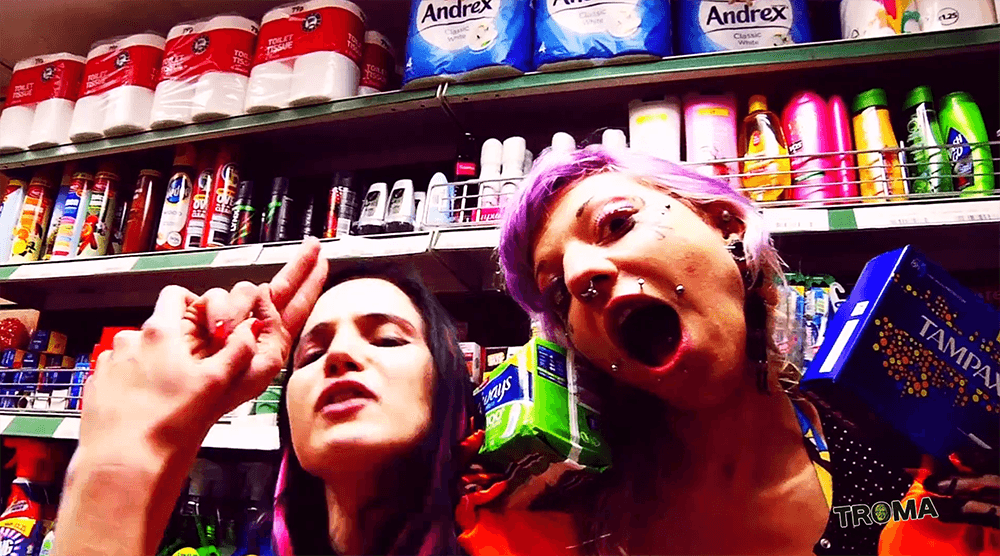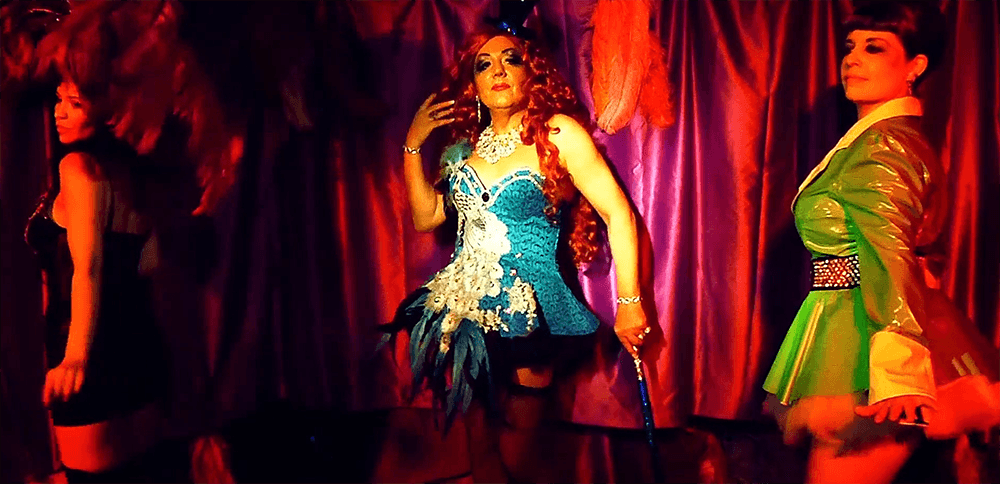
Figure 1. Matilda (Rahel Kapsaski) and Eden (Sophia Disgrace) singing “Kerching!” in Spidarlings (Troma Entertainment, 2016)
It is difficult to classify Salem Kapsaski’s Spidarlings (2016) as any one genre—or even two. Falling into the categories of punk rock, queer, comedy, horror, and musical, it is reminiscent of The Rocky Horror Picture Show (1975) and other cult classics. Unquestionably unique, the film uses fun, entertaining songs along with elements of horror and comedy to subtly deliver social commentary in a way that viewers will either absolutely love or hate.
Spidarlings tells the story of a young lesbian couple, Matilda (Rahel Kapsaski) and Eden (Sophia Disgrace). They lead a less-than-comfortable life as they struggle to make ends meet on Matilda’s income from a nightclub in Soho called “Juicy Girls” while their landlord (Chris Repps) threatens to kick them out of their apartment if they do not pay the two years of rent that they owe him. Eden only makes matters worse when she makes completely unnecessary purchases, the most significant being a tarantula named Rainer. Life becomes even more unpleasant when Matilda begins to have trouble with a regular at Juicy Girls, a psychopath goes on a killing spree, and Eden’s tarantula goes missing. However, amid all this chaos, the girls still find it appropriate to sing a catchy musical number that criticizes capitalism while shopping at the local grocery store (Figure 1).
Although aspects of the film’s plot are confusing and sometimes even disturbing, Spidarlings manages to keep its viewers engaged with its distinctive, vivid color palette and elaborate costuming, makeup, and set design. The lighting and use of color do much more to set the mood of a scene than even the actors’ performances. This is especially apparent in the first scene that takes place at Juicy Girls. The colors in this scene are mostly analogous, so the deep reds and purples in the shadows blend well with the brilliant orange and yellow highlights. The combination of the intense, warm colors and the dark, defined shadows creates a mysterious and sexy atmosphere as the women (and drag queen) dance seductively in their brightly colored, sparkly, and revealing outfits (Figure 2). While the lighting, costuming, and use of color play an important role in creating a fitting atmosphere for Juicy Girls, they also draw attention to the film’s portrayal of women in a male-dominated space. In context with the rest of the film, the exaggeration of the dancers’ provocative attire and use of colors associated with passion in this scene satirize the male desire for physical pleasure and satisfaction brought about by the sexualization of women’s bodies.
Clearly, underneath its ridiculous and amusing exterior, the film carries biting social criticisms and, from a creative standpoint, it is truly excellent. With musical numbers such as “Juicy Girls,” “Arachnosex,” and “The Good, The Mad and The Beautiful,” the film’s soundtrack is lively and enjoyable. The animated scenes are cleverly placed throughout in dream and flashback sequences, and the story is filled with hilarious quotable moments. However, it is also obvious that Spidarlings had a very small budget. The low production values contributed to various technical issues and, most importantly, it drags on for much too long. At least thirty minutes of this two-hour-long film could have been removed to improve the story’s coherency and to keep the viewer more easily engaged. Fortunately, the actors’ performances are entertaining enough to keep the film’s momentum up until the end, and the elements of horror interspersed throughout the second half help to create a certain degree of suspense.
While Spidarlings’ camp energy may deter audiences who prefer films that are more mainstream, viewers who have an appreciation for entertainment that is subversive and unapologetically strange would enjoy this film. Its faults are primarily the result of a low budget and an overlong runtime, but its strengths lie in its creative mise-en-scène and use of color, as well as its ability to keep the viewer engaged over the course of two hours. Spidarlings is not for everyone, but in the world of cult cinema, it deserves a nod of recognition, if not a round of applause.
Spidarlings is available to watch on TROMA Now!: https://troma.vhx.tv/videos/spidarlings
Author Biography
Ashley R. Spillane is an Honors student at the University of North Carolina Wilmington majoring in Film and minoring in Digital Arts. When she is not watching, making, or writing about films, she enjoys reading, painting, and experimenting with graphic design.
Film Details
Spidarlings (2016)
UK
Director Salem Kapsaski
Runtime 120 minutes








































